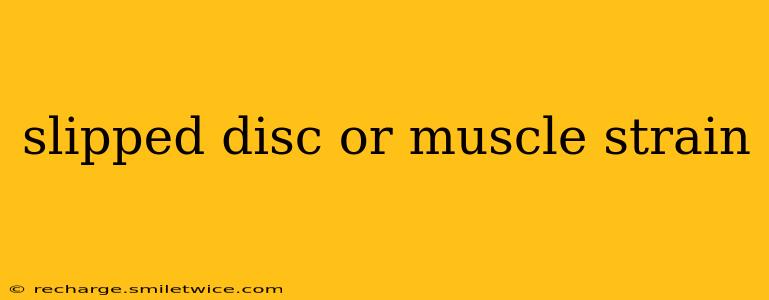Back pain is a common ailment, affecting millions worldwide. Two frequent causes are slipped discs (more accurately termed herniated discs) and muscle strains. While both can cause significant discomfort, understanding the differences is crucial for proper diagnosis and treatment. This article will delve into the key distinctions between a slipped disc and a muscle strain, helping you better understand your back pain.
What is a Slipped Disc (Herniated Disc)?
A slipped disc, or more accurately a herniated disc, occurs when the soft, gel-like center of an intervertebral disc pushes through a tear in the tough outer layer. These discs act as cushions between the vertebrae in your spine. A herniation can put pressure on nearby nerves, causing pain, numbness, tingling, and weakness that often radiates down the leg (sciatica) or arm. The location of the herniation dictates the symptoms.
What Causes a Slipped Disc?
Several factors can contribute to a slipped disc, including:
- Age: As we age, the discs naturally lose hydration and become more susceptible to tearing.
- Degeneration: Wear and tear from repetitive movements or heavy lifting can weaken the discs.
- Injury: Sudden trauma, such as a fall or car accident, can directly damage a disc.
- Poor posture: Maintaining poor posture for extended periods puts undue stress on the spine.
- Obesity: Excess weight increases the load on the spine.
What is a Muscle Strain?
A muscle strain, also known as a pulled muscle, is an injury to a muscle or tendon in the back. This often results from overstretching or tearing of the muscle fibers. Muscle strains in the back can cause localized pain, stiffness, and sometimes spasms. Unlike a slipped disc, the pain is usually confined to the affected muscle area and doesn't typically radiate down the limbs.
What Causes a Muscle Strain?
Muscle strains in the back can be caused by:
- Overexertion: Lifting heavy objects improperly or engaging in strenuous activities without adequate warm-up.
- Sudden movements: Twisting or reaching awkwardly can strain back muscles.
- Repetitive movements: Repeated bending, lifting, or twisting can lead to micro-tears in the muscles.
- Poor posture: Similar to slipped discs, poor posture can weaken muscles and make them more susceptible to strain.
- Lack of flexibility: Inadequate stretching can limit muscle flexibility and increase the risk of strain.
What are the Symptoms of a Slipped Disc vs. Muscle Strain?
Differentiating between a slipped disc and a muscle strain can be challenging, as some symptoms overlap. However, key distinctions exist:
Slipped Disc:
- Pain: Often severe, radiating down the leg (sciatica) or arm.
- Numbness/Tingling: May extend down the leg or arm.
- Weakness: Muscle weakness in the affected limb.
- Limited range of motion: Difficulty bending or twisting.
- Specific neurological symptoms: Depending on the nerve root affected, you might experience specific symptoms like foot drop or difficulty with bowel or bladder control (rare but serious).
Muscle Strain:
- Pain: Localized pain in the back, often worsened by movement.
- Stiffness: Limited range of motion due to stiffness.
- Muscle spasms: Involuntary muscle contractions.
- Tenderness to the touch: Pain when the affected area is pressed.
- Absence of radiating pain: Pain generally stays localized to the back.
How are Slipped Discs and Muscle Strains Diagnosed?
Diagnosis typically involves a physical examination and a review of your medical history. Imaging tests, such as X-rays, MRI scans, or CT scans, may be used to confirm the diagnosis, especially for a suspected slipped disc. X-rays reveal bone abnormalities, while MRI and CT scans provide detailed images of the soft tissues, including the discs and muscles.
How are Slipped Discs and Muscle Strains Treated?
Treatment depends on the severity of the condition. Options include:
- Rest: Avoiding activities that aggravate the pain.
- Ice and heat: Applying ice packs initially to reduce inflammation, followed by heat to relax muscles.
- Over-the-counter pain relievers: Medications like ibuprofen or acetaminophen can help manage pain and inflammation.
- Physical therapy: Exercises to strengthen back muscles and improve flexibility.
- Medication: Stronger pain relievers or muscle relaxants might be prescribed for severe pain.
- Surgery: In rare cases of severe slipped disc causing significant nerve compression, surgery might be necessary.
Can a slipped disc heal on its own?
Many slipped discs will heal naturally with conservative treatment like rest, physical therapy, and over-the-counter pain relief. However, the healing time varies and can be several weeks to months. Severe cases may require more extensive interventions.
How long does it take for a muscle strain to heal?
Muscle strains usually heal within a few weeks with rest, ice, and over-the-counter pain relievers. However, recovery time depends on the severity of the strain.
When should I see a doctor for back pain?
It's crucial to consult a doctor if:
- Your pain is severe or doesn't improve with home treatment.
- You experience numbness, tingling, or weakness in your legs or arms.
- You have difficulty controlling your bowel or bladder.
- You have a fever or other signs of infection.
This information is for educational purposes only and should not be considered medical advice. Always consult a healthcare professional for diagnosis and treatment of any medical condition.
